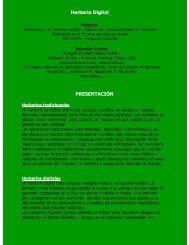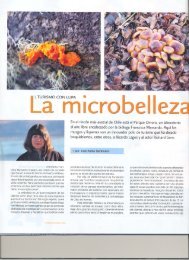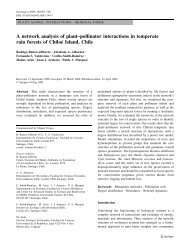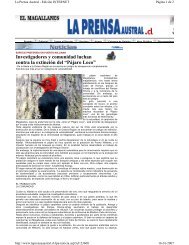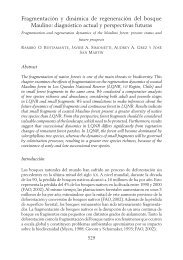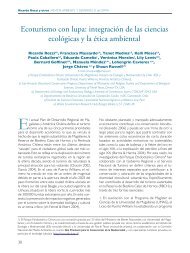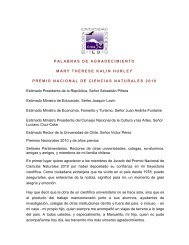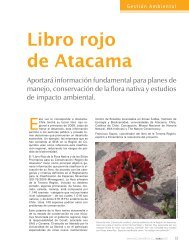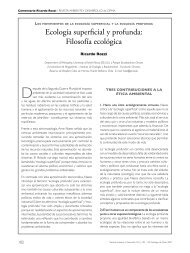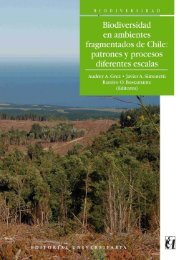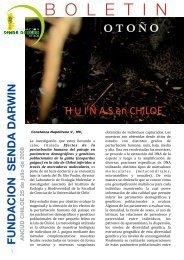Diversity of Small Mammals in the Pacific Coastal Desert of Peru ...
Diversity of Small Mammals in the Pacific Coastal Desert of Peru ...
Diversity of Small Mammals in the Pacific Coastal Desert of Peru ...
Create successful ePaper yourself
Turn your PDF publications into a flip-book with our unique Google optimized e-Paper software.
<strong>Diversity</strong> <strong>of</strong> <strong>Small</strong> <strong>Mammals</strong> <strong>in</strong> a <strong>Coastal</strong> <strong>Desert</strong>with<strong>in</strong> <strong>the</strong> desert area were <strong>in</strong>cluded (i.e. 5-24"s). The results (Table 2) show that <strong>the</strong>number <strong>of</strong> species found <strong>in</strong> <strong>the</strong> altitud<strong>in</strong>al belts above 3000 m is positively correlatedwith <strong>the</strong> total number <strong>of</strong> species with access to a particular altitud<strong>in</strong>al transect. That is,an <strong>in</strong>crease <strong>in</strong> <strong>the</strong> number- <strong>of</strong> species <strong>in</strong> latitude only affect high-altitude environments;species tend to accumulate <strong>in</strong> <strong>the</strong> highlands. The factors affect<strong>in</strong>g species diversity behavedifferently below 3000 m. Regional diversity probably affects local diversity (see Ricklefs1987) only <strong>in</strong> those areas located above 3000 m, whereas below it <strong>the</strong> existence <strong>of</strong> <strong>the</strong>coastal desert imposes a serious barrier to <strong>the</strong> passive diffusion or spill-over <strong>of</strong> species fromareas <strong>of</strong> high diversity <strong>in</strong> <strong>the</strong> highlands. In this scenario it is not surpris<strong>in</strong>g that desertlowland species may have evolved physiological adaptations, such as hydric <strong>in</strong>dependenceand torpor (see K<strong>of</strong>ord 1968; Boz<strong>in</strong>ovic and Marquet 1991), to cope with one <strong>of</strong> <strong>the</strong>world's most arid deserts (Borgel 1973).Table 2. Kendall's rank correlation coefficients between <strong>the</strong>total number <strong>of</strong> species present at each altitud<strong>in</strong>al transectand <strong>the</strong> number <strong>of</strong> species found at each altitud<strong>in</strong>al beltn, number <strong>of</strong> observations; n.s., not significant; ***, P c 0.01Altitud<strong>in</strong>al belt (m) n r PIn general, <strong>the</strong>se results are consistent with previous studies (Pearson 1951, 1982;Spotorno 1976; Pearson and Ralph 1978; Pizzimenti and DeSalle 1981) that po<strong>in</strong>t out<strong>the</strong> existence <strong>of</strong> a positive correlation between species richness and altitude <strong>in</strong> <strong>the</strong> areabetween <strong>the</strong> <strong>Pacific</strong> coastal desert and <strong>the</strong> Puna. At this po<strong>in</strong>t it is <strong>in</strong>terest<strong>in</strong>g to notethat this f<strong>in</strong>d<strong>in</strong>g contradicts <strong>the</strong> rule <strong>of</strong> decreas<strong>in</strong>g number <strong>of</strong> species with <strong>in</strong>crease <strong>in</strong>altitude (e.g. Stevens 1992 and references <strong>the</strong>re<strong>in</strong>). A negative correlation between speciesrichness and altitude is likely to arise if most speciation events have occurred <strong>in</strong> lowlandhabitats. Therefore, species' primary adaptations are suited to lowland environments, andhighlands represent, to some extent, stressful habitats that are difficult to colonise and<strong>in</strong> which to persist. However, <strong>in</strong> <strong>the</strong> case <strong>of</strong> <strong>the</strong> <strong>Coastal</strong> desert-Puna axis, <strong>the</strong> oppositeoccurs. Here, most speciation events were associated with high-altitude environments, wherea major centre <strong>of</strong> species diversification was located. The primary adaptations <strong>of</strong> <strong>the</strong>sespecies were to cope with cold, high-altitude environments, and lowland habitats were <strong>of</strong>marg<strong>in</strong>al value. Hence <strong>the</strong> positive correlation between altitude and species richness. Asan alternative hypo<strong>the</strong>sis, it could be argued that <strong>the</strong> positive correlation emerges because<strong>of</strong> <strong>the</strong> existence <strong>of</strong> a lowland hyperarid desert that limits diversity <strong>in</strong> lowland areas tosuch low levels as to produce a pattern <strong>of</strong> positive correlation that would o<strong>the</strong>rwise benegative. Although I do not deny that <strong>the</strong> onset <strong>of</strong> arid conditions <strong>in</strong> <strong>the</strong> lowlands caused<strong>the</strong> ext<strong>in</strong>ction <strong>of</strong> some species (Marquet 1989), <strong>the</strong> historical effect <strong>of</strong> a high-altitude centre<strong>of</strong> diversification seems more pervasive. The key evidence <strong>in</strong> support <strong>of</strong> this hypo<strong>the</strong>sisis <strong>the</strong> existence <strong>of</strong> a positive correlation between species richness and altitude along <strong>the</strong>eastern side <strong>of</strong> <strong>the</strong> Andes Cordillera (Patton 1986; Cadle and Patton 1988; J. Salazar,T. Yates and P. Marquet, unpublished data), where Puna vegetation gives way to Yungasforest and lowland tropical ra<strong>in</strong>forest.As emphasised earlier, <strong>the</strong> existence <strong>of</strong> a high-altitude centre <strong>of</strong> biotic diversification hasaffected both latitud<strong>in</strong>al and altitud<strong>in</strong>al patterns <strong>of</strong> species diversity, leav<strong>in</strong>g strong signsbeh<strong>in</strong>d, such as a latitud<strong>in</strong>al peak <strong>in</strong> species richness (Fig. 4) and an 'anomalous' positivecorrelation between species richness and altitude. The onset <strong>of</strong> hyperarid conditions dur<strong>in</strong>g



